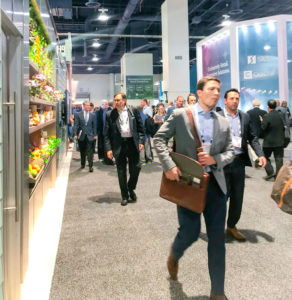
Pavement pounding at RECon in a sea of retail players old and new, who are all looking to capitalize on the new shopping environment.
I’m fresh back from ICSC’s RECon in Las Vegas and it sure is an invigorating experience! My mission, of course, was to connect with retail faces both old and new, but in my most recent capacity as president of Crossroads Retail Advisors. Just as important, however, was pounding the showroom floor to gather information that would benefit my clients. Because today’s retail environment is all about data and what you do with it, right?
The overall mood was extremely positive and the Las Vegas Convention Center was packed all four days. If I could describe my observations on the floor in one word, it would be opportunity!
Below are five of the 10 essential elements I took from my recent time in the desert at RECon.
- It’s a Tenant’s Market
Class A centers in premier locations will always be in high demand. Nearly every developer and landlord I encountered at RECon is willing to negotiate elements in the lease that were essentially off the table in years past. These include pop-up spaces, kick-outs, short-term leases of around five years, revised co-tenancy clauses and percentage rents to a certain volume level that then morphed into hard rent numbers. It’s a great time to be an entrepreneur with a solid business model or a current operator looking to expand your operations.
- Consumers Yearn for Novelty, Diversity
There will always be demand for national, AAA-rated credit tenants, however, developers and landlords are now willing to take calculated risks on “e-tailers” and start-ups with no brick and mortar presence. They’re also open to local and regional players with stellar reputations and large followings, which can come from in-store traffic, online sales and social media followers. The “three Fs” are particularly sought-after. If you don’t know what those are, they’re fitness, fun and food!
- Pure-Play Retail is Dead
Ecommerce companies are ironically opening brick-and-mortar locations because they know they cannot capture the full spectrum of consumers without this formerly missing puzzle piece. Statistics show online sales tend to increase between 10 percent and 35 percent in regions where ecommerce companies establish a brick-and-mortar presence. Return processing costs can also be significantly reduced with a storefront. On the flipside, those shops that want to succeed are ramping up their omnichannel strategies and online presences as they seek to foster a connection with consumers both when they’re at their shopping centers and when they’re home on their phones.
- Public Agencies are Willing and Able Partners to Retailers
More than 100 U.S. cities, towns and municipalities exhibited a presence at RECon. This is always a great opportunity to discover new and up-and-coming markets with future growth potential that commonly have low barriers to entry with favorable zoning and permitting. I’m particularly interested in outlying areas with large, new fulfillment centers and newly developed, state-of-the-art manufacturing facilities. These features, paired with convenient access to interstates and rail transportation, not to mention strong housing growth rates, can turn opportunity into signed deals as we all know retail follows rooftops. As large metro areas become expensive and saturated, these regions represent great potential for middle-market concepts.
- Investment Money is There… If You Know Where to Look
Entrepreneurs and mom and pops don’t have to beg a bank or compete for a spot on Shark Tank to find investment funds for their concepts. I talked to more than a couple of entities that are willing to invest in businesses with solid foundations. These players can also provide expertise in other growth-related operational areas.
Stay tuned for the final five takeaways in our next Crossroads blog!
